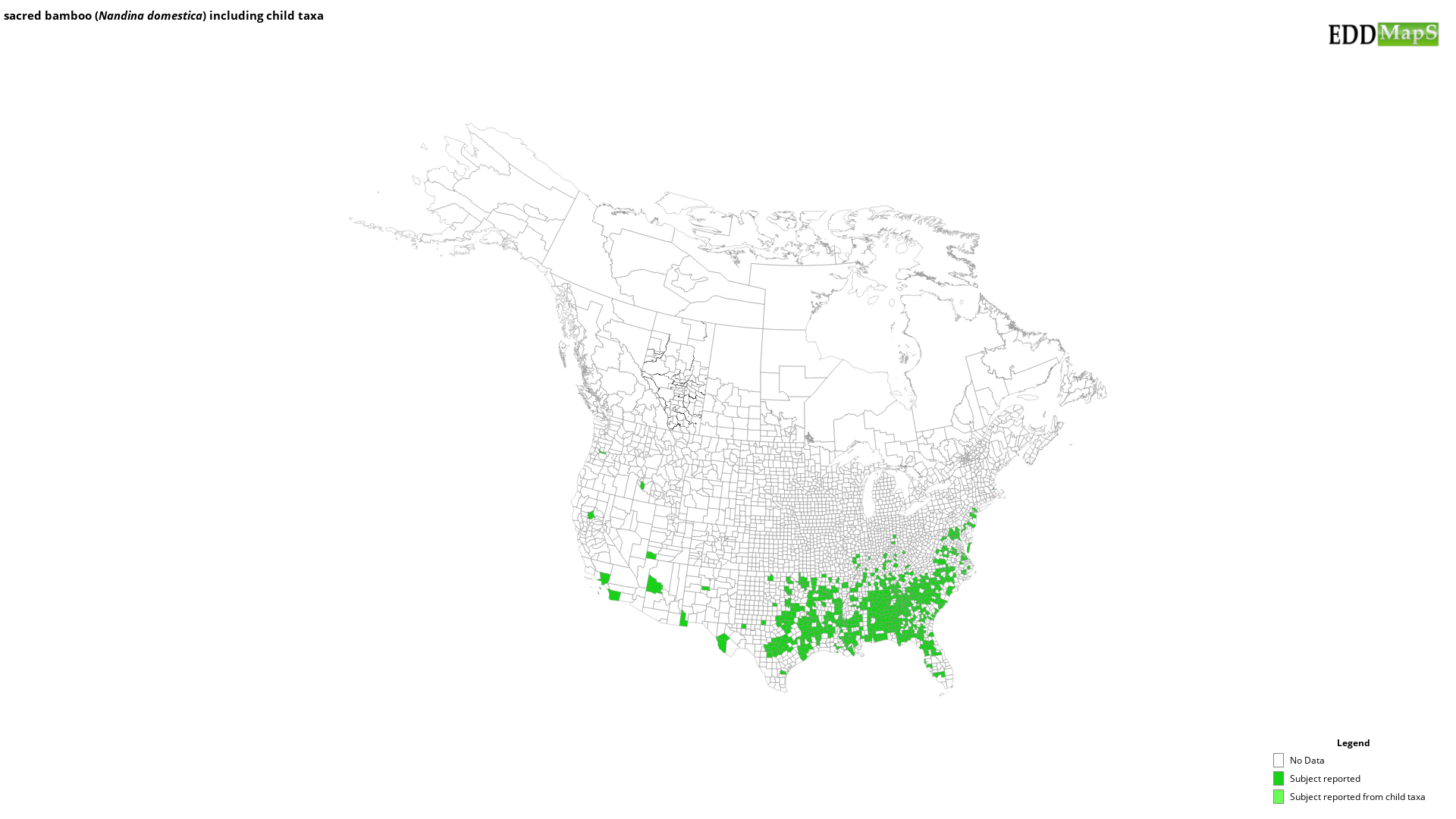sacred bamboo
(Nandina domestica)
This species is Introduced in the United States
Appearance
Nandina domestica invades forests throughout the Southeast United States. It is a small, erect shrub that grows up to 8 ft. (2.4 m) tall.
Foliage
Leaves are alternate, large, bi- or tri-pinnately compound with small, 1-2 in. (2.5-5.1 cm) long leaflets. The older stems have bark with long, linear furrows. The overlapping leaf sheaths give the main stem the appearance of bamboo, hence the name.
Flowers
Flowering occurs in the spring, when small, white flowers develop in large panicles at the ends of the stems. Flowers have 3-6 reflexed petals.
Fruit
Fruits are green berries that mature to a bright red and are very attractive to birds.
Ecological Threat
Nandina domestica is shade tolerant, which allows it to invade forest edges and interiors. It is native to eastern Asia and India and was first introduced to North America in the early 1800s. It has been planted widely as an ornamental and often escapes from old plantings.
Nandina domestica berries contain small amounts of cyanide which can negatively affect birds that eat them. Especially birds like cedar waxwings whom in nature, gorge themsleves on red berries of native trees and shrubs, and have regularly feasted upon the toxic berries of Nandina domestica as well, which can lead to poisoning.
Resources
- Images, Video and Information - University of Florida - Center for Aquatic and Invasive Plants
- Invasive Species Management Plans for Florida - University of Florida - Center for Aquatic and Invasive Plants
- A Field Guide for the Identification of Invasive Plants in Southern Forests - USDA Forest Service
- Invasive Species Management Plans for Florida - University of Florida
- Weed of the Week - USDA Forest Service
Selected Images
Maps
EDDMapS Distribution - This map is incomplete and is based only on current site and county level reports made by experts, herbaria, and literature. For more information, visit www.eddmaps.org
State Regulated List - This map identifies those states that have this species on their regulated list or invasive species law.
Invasive Listing Sources
- Alabama Invasive Plant Council
- Alachua County Cogongrass Initiative
- Apalachicola Invasive Working Group
- Florida Invasive Plant Council - Plant List - Category I
- Georgia Exotic Pest Plant Council - Category 2
- Jil M. Swearingen, Survey of invasive plants occurring on National Park Service lands, 2000-2007
- Kentucky Exotic Pest Plant Council - Watch List
- Maryland Code and Regulations of Invasive Plants
- Maryland Department of Natural Resources Policy: Restriction on Planting Exotic Invasive Plants
- Maryland Invasive Species Council - Invasive Species of Concern in Maryland
- Missouri SRISP Species List
- National Park Service, Mid-Atlantic Exotic Plant Management Team Invasive Plant List
- National Park Service, National Capital Region Exotic Plant Management Team Invasive Plant List
- Non-Native Invasive Plants of Arlington County, Virginia
- Nonnative Invasive Species in Southern Forest and Grassland Ecosystems
- Reichard, Sarah. 1994. Assessing the potential of invasiveness in woody plants introduced in North America. University of Washington Ph.D. dissertation.
- South Carolina Exotic Pest Plant Council
- Tennessee Exotic Pest Plant Council
- Virginia Invasive Plant Species List
- Virginia Master Naturalists Priority Species List
- WeedUS - Database of Plants Invading Natural Areas in the United States
Taxonomic Rank
| Kingdom: Plantae |
| Phylum: Magnoliophyta |
| Class: Magnoliopsida |
| Subclass: Magnoliidae |
| Order: Ranunculales |
| Family: Berberidaceae |
| Genus: Nandina |
| Subject: Nandina domestica Thunb. |
References
Common Name Reference: USDA, NRCS. 2010. The PLANTS Database. National Plant Data Center, Baton Rouge, LA, USA.
Scientific Name Reference: USDA, NRCS. 2010. The PLANTS Database. National Plant Data Center, Baton Rouge, LA, USA.


